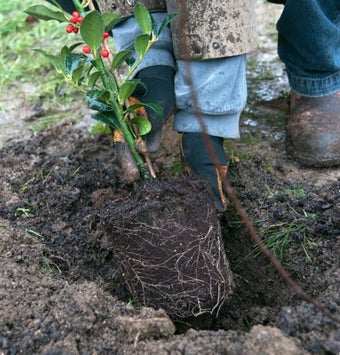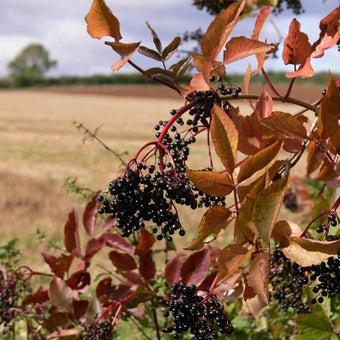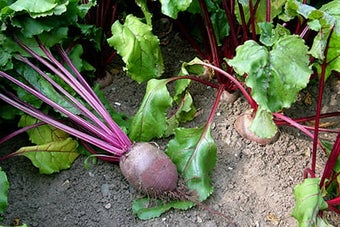
Quick facts
Suitable for - Crab apples, damsons, sloes, elderberries, blackberries, rosehips and more
Timing - Summer and autumn
Difficulty - Easy
When to harvest fruit from hedgerows
Most hedgerow fruit is ready to harvest in summer and autumn.
What fruit may I find?
Below are some edible fruits commonly found in hedgerows:
Crab apples (Malus sylvestris)
- Small, hard apples ranging from yellow to red
- Small trees in hedgerows and parks
- Autumn
- Unpalatable raw but good for jelly
Cherries (Prunus avium, P. cerasus and P. padus)
- Bright or deep red stone fruit
- Small and medium-sized trees and shrubs in hedgerows and parks
- Late summer
- Some are edible raw, others are too sour or bitter but all are excellent for wine, jams or cooking
Cherry plums (Prunus cerasifera)
- Round, plum-like red or yellow stone fruit
- Small trees in hedgerows and parks
- Late summer
- Useful for jams and baking
Damson and bullace (Prunus domestica subsp. instita)
- Deep purple, oval stone fruit
- Small and medium-sized trees and shrubs in hedgerows and parks
- Autumn
- Sometimes palatable raw but always good for jams, jellies, chutneys, bottling and baking
Sloe (Prunus spinosa)
- Small, hard, round, purple stone fruit
- Small, thorny shrubs and trees in hedgerows
- Autumn
- Unpalatable raw but excellent for fruit liqueur
Elderberry (Sambucus nigra)
- Flattened panicles of scented white flowers followed by small glossy, round black berries
- Upright, bushy shrubs in hedgerows, verges, woods and thickets
- Flowers in early summer, fruit in late summer
- Flowers used in cordial and wine, berries are only edible cooked and can be used in wine and jellies
Rosehips (Rosa canina, R. rubiginosa and other species)
- Oval, bright orange-red hips
- Thorny, arching shrubs and climbers in hedges and thickets
- Autumn
- The hair around the seeds is an irritant but once fruit is cooked and strained to make syrup or jelly it is delicious, with high levels of vitamin C
Blackberries or brambles (Rubus fruticosus)
- Ubiquitous black-berried fruits
- Thorny shrubs found in hedgerows, scrub and rough ground
- Late summer and early autumn
- Eat raw or use in jams or pies
Hawthorn (Crataegus monogyna)
- Small, round dark-red berries held in bunches
- Shrubs and small trees in hedgerows
- Autumn
- Simmer for a long time with apples to make a thick jelly
Guelder rose (Viburnum opulus)
- Small, sticky, bright-red fruits in clusters
- Upright shrubs
- Late summer and early autumn
- Poisonous raw but edible cooked in jellies and sauces
Other fruits
Many cultivated trees in gardens and parks such as strawberry-tree (Arbutus unedo) and snowy mespilus (Amelanchier lamarkii) have fruits that can be used for culinary purposes.
Bush and fruits such as raspberries, gooseberries, red and blackcurrants may also be found in scrubland, woods, parks and hedgerows, usually as garden escapes.
Scrub and moorland can also be a good foraging environment, with low-growing shrubs yielding bilberries (Vaccinium myrtillus), cowberries (V. vitis-idaea) and cranberries (V. oxycoccus).
Books for reference
Food for Free by Richard Mabey (Collins 2001, ISBN 9780002201599)
Wild Food by Roger Phillips (Pan Books 1983, ISBN 9780330280693)
The Concise British Flora in Colour by W. Keble Martin (Ebury Press/Michael Joseph 1969, ISBN 9780718140281)
These books are also available through the Lindley Library.
Remember...
- Carry a plant identification guide if in any doubt
- A berry comb or berry picker is a useful tool to harvesting small berries
- Use clean bags and containers for collection
- Wash fruit before use
- A number of fruits must be cooked before being safe to eat
Problems
Correct identification of fruit is important. If in any doubt, do not eat. RHS members can contact RHS Gardening Advice for help with plant identification.
Avoid fruits growing in polluted areas or low down where dogs may have urinated.
Maggots are as prevalent on wild fruit as they are on cultivated forms.




